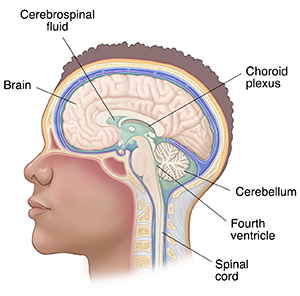Choroid Plexus Papilloma
Choroid plexus papilloma (CPP) is a rare type of brain tumor. It's generally benign (not cancer). Benign also means that the growth doesn't spread to other parts of the body. CPP is most common in young children, but it can also appear in adults. CPP are generally slow-growing tumors. It's very rare for this type of tumor to spread outside the brain. In atypical CPP, the tumor is more likely to grow faster or come back after treatment.
How CPP causes problems
A CPP tumor grows in the choroid plexus. This is a layer of tissue within the brain that makes the cerebrospinal fluid (CSF). CSF surrounds and cushions the brain and spinal cord. The choroid plexus lines the ventricles of your brain, which store the CSF. The choroid plexus is made of connective tissue, blood vessels, and the ependymal cells.
In adults, CPP tends to form in the fourth ventricle. This is next to the cerebellum, near the back of the brain and close to the brainstem. The cerebellum is the part of your brain that controls your balance and coordination. The brainstem is an important part of the lower part of your brain.
CPP may cause your brain to make too much CSF. It might also block the normal drainage of CSF. This excess CSF in the brain (hydrocephalus) can create pressure in the brain that can be dangerous.

What causes CPP?
Researchers don't yet know what causes CPP. It's possible that certain infections, genes, immune system problems, or the environment plays a role in causing these tumors. In some cases, CPP may be linked with certain rare gene changes (mutations).
Symptoms of CPP
CPP most often leads to increased pressure in the brain. This can cause symptoms such as:
-
Headache (common)
-
Nausea and vomiting
-
Sleepiness
-
Eye problems (secondary to cranial nerve deficits)
-
Dizziness and balance problems
-
Trouble walking
-
Seizures (rare)
-
Psychosis (rare)
- Changes in hearing
Your symptoms may be different, depending on where the CCP tumor is in your brain. Your symptoms may start slowly and get worse over time.
Diagnosing CPP
The process starts with a medical history and a physical exam. Your healthcare provider will ask about your symptoms and past medical conditions. They may also ask about your family’s medical history. The physical exam may include a nervous system exam. During this exam, your healthcare provider may ask you to do things like walk, touch your finger to your nose, or hold your hands out. They may look in your eyes with a light. Tests may be done, such as:
-
Biopsy. Small pieces of tissue are taken from the tumor. They are looked at with a microscope in a lab.
-
CT scan. This is a test that uses a series of X-rays and a computer to create images of the inside of the body. Scans may be done of your brain.
-
MRI. This test uses large magnets and a computer to create images of the body. MRI scans of your brain may be done to get more information. Contrast dye may be used to help show more detail in the images.
Treatment for CPP
The main treatment for CPP is surgery. Complete removal of the tumor with surgery usually cures CPP. These tumors rarely come back. In most cases, people with CPP have a good outcome after surgery.
If a CPP tumor is only partly removed, it may grow again, but it likely will not spread. An atypical CPP is a bit more likely to come back after treatment. If CPP does come back, you may need chemotherapy or radiation therapy to treat it.
You will need to work with your healthcare team to decide on the best treatment plan for you. You will need to have ongoing follow-up with your healthcare provider. This will include repeated imaging tests to check if the tumor comes back.
What happens if you don’t get treated?
Fluid in the brain (hydrocephalus) is a common complication. This is because CPP occurs in the ventricles of the brain filled with CSF. You may need a tube to drain excess CSF and lower the pressure in your brain. After the tumor is removed, this problem will likely go away.
In rare cases, surgery can cause problems. For example, there is a very small chance of a problem with the facial nerve. This could cause paralysis of part of your face. This is a rare problem.